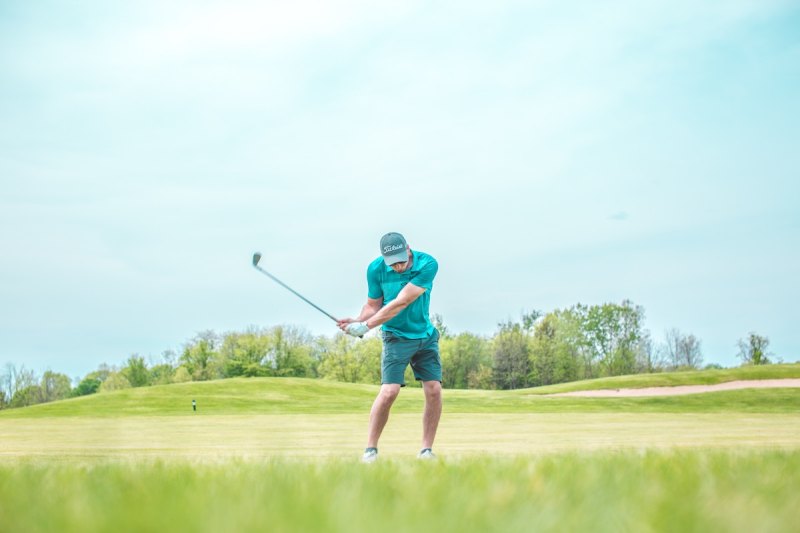
A golfer’s elbow can cause anyone, golfer or non-golfer, a tremendous amount of pain. The discomfort is usually located where your forearm’s tendon muscles attach to a rather bony bump inside of your elbow. Then that pain can spread into your lower forearm and the wrist area.
Golfer’s elbow is a lot like a tennis elbow, except it occurs on the inside rather than outside of the elbow. Anyone who consistently uses their wrists or clenches their fingers can develop golfer’s elbow. This includes cooks, writers, mechanics, and athletes of all kinds.
You don’t have to permanently give up your favorite sports or stay away from hobbies you love. The pain you’re experiencing will almost always subside after proper rest and the appropriate treatment.
What is golfer’s elbow?
Golfer’s elbow is known in the medical world as medial epicondylitis. This condition is a form of tendonitis. It causes inflammation and subsequent pain in the area where your forearm and elbow connect.
If you use your wrist and arm repeatedly while bending, grasping, or twisting things, you can develop this painful condition. That’s because your tendons can tear in tiny ways that add up, causing pain in your wrists, elbows, and forearms.
Swinging a golf club isn’t the only way to develop golfer’s elbow. If you repeatedly swing a baseball bat, carry heavy piles of lumber, wash dishes in a busy kitchen, or write thousands of words every day on your computer; you too, can suffer from this condition.
Any kind of tendonitis causes rips in tendons, and golfer’s elbow is no different. If you don’t get treatment early, this pain can morph into serious damage that you’ll have to deal with for the rest of your life. That will likely limit your elbow’s range of motion in addition to causing chronic pain and weakening your grip.

How do you get golfer’s elbow?
Golfer’s elbow is normally caused by overusing the muscles in your forearm. This happens during routine movements, such as gripping with your hands, rotating your arms, and flexing your wrists. Think about your daily activities. How many times do you flex, grip, or swing in a way that causes you to pull or tear your tendons?
Again, don’t let the name fool you. Even if you’ve never stepped foot on a golf course, you can suffer from this ailment. Consider the following ways you can acquire golfer’s elbow without even realizing it. Do you do any of the following?
- Play any kind of racket sport, like pickleball or tennis?
- Engage in sports without using proper form or techniques?
- Handle rackets, clubs, or other sporting equipment incorrectly and end up hurting your tendon?
- Use rackets that are too light or too heavy?
- Play sports that require a lot of throwing movements, like bowling, baseball, football, javelin throwing, archery, or softball?
- Pitch balls incorrectly?
- Move repetitively for work in fields, such as painting, carpentry, plumbing, or construction?
- Engage in weight training without using the right technique and end up overworking your elbow’s tendons and muscles?
- Use tools, such as screwdrivers, hammers, rakes, or paintbrushes for hours a day?
If you answered yes to any of the above questions, you may be at risk of having golfer’s elbow.

What are the symptoms of golfer’s elbow?
With this condition, you can feel pain suddenly or over a long period. Symptoms may include the following:
- Elbow stiffness
- Tenderness on the inner side of your elbow or forearm
- Pain in the same area when making a fist or swinging your arm
- Numbness in your fingers
- Tingling between your ring and little fingers
- Weak hands and wrists
- Decrease strength in your grip
Medial epicondylitis (or golfer’s elbow) symptoms can often feel worse when you first wake up in the morning.
Prevent golfer’s elbow by being mindful of your wrist and forearm during warmups as you prepare to exercise or play your favorite sports. Consider talking to a performance coach about your form and technique or the benefits of adjusting your sports equipment.
For example, if you play tennis, a larger grip on your racquet might ease symptoms. Loosening your racquet strings can also help prevent this condition. Improving your serve or stance when batting or hand placements can also put less stress on your forearm.
If you work in a job where you use your hands and wrists a lot, consider talking to a physical therapist or your doctor about braces that can help support your wrists. You can also learn gentle stretches or rest periodically throughout the day.

How to treat golfer’s elbow at home
Ice
For 15 to 20 minutes at a time, apply ice packs to your arms and wrists. Do this three to four times a day for several days until the pain subsists. Wrap the ice packs in a thin towel to protect your skin from the cold. It can also help to massage your inner elbow with individual ice cubes for about 5 minutes or so a few times a day.
Rest
Pain is your body’s way of telling you something. Maybe you need some rest. Take a break from your golf game or other repetitive activities until you feel better. If you push yourself and return to the activity too quickly, you can make matters worse.
Medications
Speak to your doctor. For moderate flare-ups, you may need to take an oral NSAID (nonsteroidal anti-inflammatory drug.) This includes ibuprofen, aspirin, or naproxen. It can reduce swelling and the pain that comes with it. Similarly, a topical medication may also help.
Protect your arm
Wearing a day brace or a night splint can help. Any counterforce brace on your affected arm should reduce tendon and muscle strain and accelerate healing.
Stretches
Several gentle stretching and strengthening exercises have helped people reduce pain in their wrists and elbow. Talk to a physical or occupational therapist for specific strength training exercises. Progressive loading of the tendon has also shown to be especially helpful.

When do you need to see a doctor?
If you’re concerned, talk to your doctor immediately upon feeling pain. They can usually diagnose a golfer’s elbow based on a physical exam and discussion about your medical history. Qualified physicians can apply pressure to different affected areas or ask you to demonstrate how you move your elbow, wrist, and fingers in different ways.



